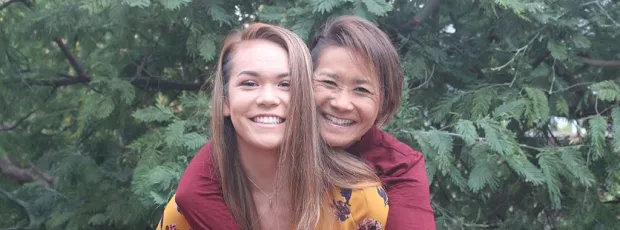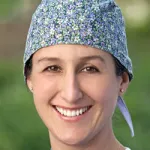
Photo courtesy Ginger Powell: Ginger Powell says she's grateful that the cancer treatment she received at Stanford
Health Care helped her spend more time with her daughter.
Stanford Medicine News Center - April 19th, 2018 - by Grace Hammerstrom
Many people believe that only smokers are at risk for lung cancer, yet that’s far from the truth. Take the case of Ginger Powell.
Eight years ago, when Powell was 42, she was diagnosed with stage-4 lung cancer. A persistent shortness of breath became bothersome enough to send her to the doctor, and a chest X-ray identified fluid surrounding her heart — fluid that was found to contain cancer cells. A lifelong nonsmoker, Powell was treated aggressively with a standard chemotherapy protocol. That was followed by surgery to remove a tumor on her left lung and subsequent radiation to eradicate spots her medical team found in her esophagus.
“That’s when my life changed,” recalled Powell, who lives in San Jose, California. The radiation scorched the inside of her throat, leaving scarring that burned each time she swallowed. “It felt like I was swallowing glass,” she said.
And then the coughing began. Day and night, Powell coughed uncontrollably. Her condition worsened. She developed an esophageal perforation — essentially a tear in her throat cavity — that surgeons patched using a stent. Powell spent most of a year in and out of the hospital. Her cough worsened. She was unable to eat. And she had developed a massive infection in her chest cavity. That’s when she was referred to Stanford Health Care.
The path to recovery
“She was really, really sick,” said Heather Wakelee, MD, professor of oncology at the Stanford School of Medicine. “The surgical specialties here at Stanford were the ones to help her get onto a better recovery path.” They removed the stent from her throat, patched the perforation and placed her on intravenous antibiotics for months. Slowly, Powell began to heal.
Throughout the battle with the infection, she was free of any active cancer. Wakelee said she believes Powell’s infection may have set off a strong immune response in her body, which contributed to her being cancer-free for a period of time.
But that changed in 2014. Powell began experiencing intense headaches. An MRI identified six tumors in her brain, one of which was impeding her hand strength. Her medical team at Stanford — Wakelee; Iris Gibbs, MD, professor of radiation oncology; and Melanie Hayden Gephart, MD, associate professor of neurosurgery — determined the best and safest treatment course was to surgically remove the primary tumor causing the most severe symptoms and target the other tumors in her brain nonsurgically.
“We were hoping to shrink the tumors further to spare her a more extensive surgery,” said Wakelee, so the team tried chemotherapy as part of a clinical trial. When Powell didn’t respond to the chemotherapy, her medical team used CyberKnife to deliver high doses of radiation directly to her tumors without damaging surrounding tissue.
“CyberKnife was developed here at Stanford and has been a key part of her treatment, both to the brain and also to her bone where she had some metastases,” Wakelee said. Powell also received microwave ablation, a therapy that uses heat to destroy tumors, for a spot on her liver.
Targeted approach
The Stanford team has been able to use a more targeted approach, rather than relying on systemic chemotherapy, to treat Powell’s recurrences because her cancer has been relatively slow-growing. Patients often tolerate radiation therapy better than systemic therapy, Wakelee said.
Powell has been able to continue working and has had the energy to raise her daughter, who was 8 when she was first diagnosed.
“We could have justified having her on systemic chemotherapy this whole time, but we decided to focus more on watching her closely and using radiation when needed,” Wakelee said. “Our team is closely aligned, trying at each step to figure out the best thing for her. We have been able to keep her active and somewhat off treatment.”
Today, Powell is free of any new cancers, and is closely monitored every three months. Her tumor has been identified as HER2 positive, which Wakelee said opens up new treatment options in the future, if necessary. “If she does have to face systemic treatment, she’ll have a whole lot of other choices, including trial options, that she didn’t have when she was first diagnosed,” Wakelee said.
“Everything that has happened to me Stanford has been able to treat,” Powell said. “Being cared for at Stanford gives me so much hope. My medical team has been able to address any new site where my cancer has returned. I feel like I am receiving the best care from my doctors and nurses at Stanford. They have made my medical journey possible. I just try to remain positive and am grateful for everything I have.”

